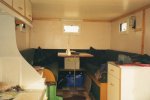Deleted member 207
Guest
A very basic split charger system is just a 100A solenoid that turns off when the alternator is not running.
So to install.
Disconnect the positive from your starting battery.
Run a cable between the positive of your starting battery to the positive of your leisure battery without hooking anything up.
At a convenient spot close to the starting battery cut the cable and then hook up the solenoid as per the instructions that came with it including a fuse.
Now you need to find the + signal wire that comes from the alternator - this is the one that turns off the red light on the dash.
You use the signal wire to turn on the solenoid and allow current to pass to the leisure battery, dont forget a fuse.
Make sure that all the wires are properly secured and extra insulation is put on the wire where any rubbing is likely to occur.
Now you can hook up the battery wires.
The leisure battery needs and earth to the vehicle body.
So to install.
Disconnect the positive from your starting battery.
Run a cable between the positive of your starting battery to the positive of your leisure battery without hooking anything up.
At a convenient spot close to the starting battery cut the cable and then hook up the solenoid as per the instructions that came with it including a fuse.
Now you need to find the + signal wire that comes from the alternator - this is the one that turns off the red light on the dash.
You use the signal wire to turn on the solenoid and allow current to pass to the leisure battery, dont forget a fuse.
Make sure that all the wires are properly secured and extra insulation is put on the wire where any rubbing is likely to occur.
Now you can hook up the battery wires.
The leisure battery needs and earth to the vehicle body.

